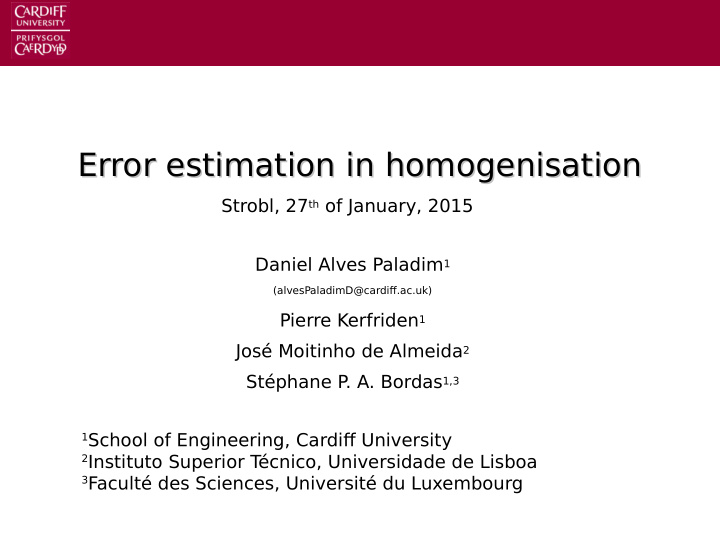



Error estimation in homogenisation Error estimation in homogenisation Strobl, 27 th of January, 2015 Daniel Alves Paladim 1 (alvesPaladimD@cardifg.ac.uk) Pierre Kerfriden 1 José Moitinho de Almeida 2 Stéphane P . A. Bordas 1,3 1 School of Engineering, Cardifg University 2 Instituto Superior T écnico, Universidade de Lisboa 3 Faculté des Sciences, Université du Luxembourg
Motivation Problem: Analysis of an heterogeneous materials. Vague information available. The position of the particles is not available. 2
Motivation Problem: Analysis of an heterogeneous materials. Vague information available. The position of the particles is not available. Solution: Homogenisation. 2
Motivation Problem: Analysis of an heterogeneous materials. Vague information available. The position of the particles is not available. Solution: Homogenisation. New problem: Assess the validity of the homogenisation. 2
Proposed solution Idea: Understand the original problem as an SPDE (the center of particles is a random variable) and bound the distance between both models 3
Proposed solution SPDE: Stochastic partial difgerential equation. Collection of parametric problems + probability density function 3
Proposed solution QoI: Quantity of interest. The output. Scalar that depends of the solution. (linear) 3
Proposed solution QoI: Quantity of interest. The output. Scalar that depends of the solution. (linear) 3
Problem statement Heat equation Heterogeneous problem 4
Problem statement Heat equation Heterogeneous problem Homogeneous problem 4
Problem statement Heat equation Heterogeneous problem Homogeneous problem Aim : Bound The computation of the bound must be deterministic. 4
Derivation Hypothesis Deterministic boundary conditions 5
Derivation Hypothesis Deterministic boundary conditions Constant volume fraction 5
Derivation Hypothesis Deterministic boundary conditions Constant volume fraction Constant PDF over the domain 5
“Flux” FE The unknown is the fmux fjeld and are fulfjlled strongly. 6
“Flux” FE The unknown is the fmux fjeld and are fulfjlled strongly. In contrast, in “temperature” FE , the temperature is the unknown and 6
“Flux” FE The unknown is the fmux fjeld and are fulfjlled strongly. In contrast, in “temperature” FE , the temperature is the unknown and In order to derive bounds, we will also need to use an homogenised “fmux” FE solution 6
Error in the energy norm Rewriting the problem in terms of the fmux and the temperature 7
Error in the energy norm Rewriting the problem in terms of the fmux and the temperature will fulfjll exactly the fjrst 2 equations. 7
Error in the energy norm Rewriting the problem in terms of the fmux and the temperature will fulfjll exactly the fjrst 2 equations. will fulfjll exactly the 3 rd equation. 7
Error in the energy norm Rewriting the problem in terms of the fmux and the temperature will fulfjll exactly the fjrst 2 equations. will fulfjll exactly the 3 rd equation. In general, Discrepancy = measure of the error 7
Error in the energy norm Formalizing this idea, it can be shown that 8
Error in the energy norm Formalizing this idea, it can be shown that Expanding 8
Error in the energy norm Formalizing this idea, it can be shown that Expanding Deterministic quantity 8
Error in the quantity of interest The error in energy norm is not always relevant. Solution: Bound for the quantity of interest 9
Error in the quantity of interest The error in energy norm is not always relevant. Solution: Bound for the quantity of interest Dual problem 9
Error in the quantity of interest The error in energy norm is not always relevant. Solution: Bound for the quantity of interest Dual problem 9
Error in the quantity of interest The error in energy norm is not always relevant. Solution: Bound for the quantity of interest Dual problem Cauchy-Schwarz inequality 9
Error in the quantity of interest The error in energy norm is not always relevant. Solution: Bound for the quantity of interest Dual problem Cauchy-Schwarz inequality Use the bound in the energy norm, 9
Validation The quantity of the interest is the average temperature in the exterior faces. The “exact” quantity of interest is computed with 512 MC realisations. 10
Validation The quantity of the interest is the average temperature in the exterior faces. The “exact” quantity of interest is computed with 512 MC realisations. 10
Validation 11
Validation Studied in a domain homogenised through rule of mixture. 12
Validation Studied in a domain homogenised through rule of mixture. Dual problem 12
Validation Studied in a domain homogenised through rule of mixture. Dual problem T wo problems solved twice: – Using “temperature” FE – Using “fmux” FE 12
Validation 13
Validation Around 60 000 elements Around 2000 elements 512 problems, 512 difgerent meshes 4 problems, 1 mesh Full PDF Bounds on the expectation 14
Work in progress – A bound on the variance. 15
Work in progress – Enhanced model. Insert patches with particles in parts of the domain. 15
Summary – A bound for the homogenisation error was presented. – The computation of the bound is deterministic. – The error estimate, should be used with care when there is a high contrast between the material properties. 16
Summary – A bound for the homogenisation error was presented. – The computation of the bound is deterministic. – The error estimate, should be used with care when there is a high contrast between the material properties. Thank you for your attention. 16
Recommend
More recommend